It’s important to keep some Halloween dog safety tips in mind, especially if you plan to paint your dog, dress your pup in a Halloween costume, or pass out candy to trick-or-treaters. That’s why integrative veterinarian Dr. Julie Buzby invited her friend, emergency veterinarian Dr. Kathryn Williams, to the blog. Dr. Williams shares seven things she wishes all dog parents knew about Halloween safety for dogs.
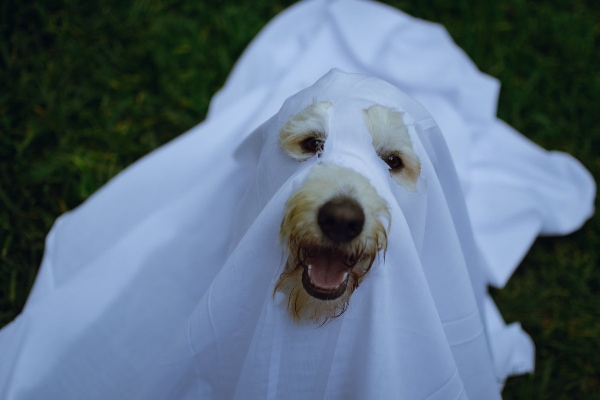
I can’t think of a better way to summarize working emergency medicine than to quote Michael Scott from The Office, “I’m not superstitious, but I am a little stitious.” Given that you never know what is going to walk in the door, every emergency doctor has their own superstitions—cases tend to come in threes, the full moon brings in crazy cases, and you never, ever, EVER say “it’s quiet” or all heck will break loose.
Halloween is no different. Maybe it’s because we know that in addition to ghouls and goblins going from door to door for candy, there are real dangers lurking behind the festivities. However, that’s no reason you and your dog cannot safely celebrate Halloween together.
7 Halloween Dog Safety Tips
Below are my favorite dog Halloween safety tips to help keep your dog safe during the spookiest time of year.
1. Halloween candy is for you not your dog.
Halloween would not be complete without candy. However, every year I see several cases in the ER where a dog ate Halloween candy. Several doggie dangers can hide in the candy bowl:
- Chocolate can kill a dog (especially dark or baking chocolate, but even milk chocolate can be dangerous)
- Xylitol is toxic to dogs and is a common ingredient in sugar free candy or baked goods (note that xylitol may also be listed on a label as “birch sugar”)
- Raisins can cause severe kidney failure in dogs
- Eating the candy wrappers can put your dog at risk for an intestinal obstruction, which may require surgery to correct.
To keep your dog safe, store candy in a high cabinet. Or put it in your pantry with the door closed until the festivities begin. Then keep the bowl of candy out of reach, such as on a high table, in between trick-or-treaters.
Get help immediately if your dog eats Halloween candy
If your dog does get into Halloween candy, immediately seek veterinary attention. Call ASPCA Poison Control at 1-800-222-1222 or Pet Poison Helpline at 1-800-213-6680.
The veterinary toxicologists employed by either of those companies can tell you if your dog ingested a toxic amount of the candy and needs an emergency vet visit. They will also provide the emergency clinic with a thorough treatment plan to help your dog. There is a fee associated with the service but having the expertise of highly trained toxicologists makes it worth every penny.
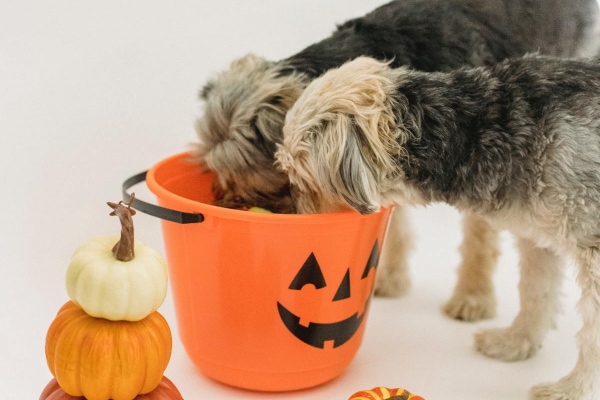
Let me reiterate that time is of the essence when your dog consumes a potential toxin. It is ideal to get to the vet ASAP if your dog got into Halloween candy, or if your dog ate Halloween candy wrappers. That way the vet may be able to help your dog vomit before the toxin or wrappers become a problem.
2. Provide safe Halloween treats for your dog (and other dogs who might come trick-or-treating).
If you are looking for a dog-safe treat for your dog’s Halloween bucket, consider making some homemade holiday dog treats. The recipe has been reviewed by a board-certified veterinary nutritionist and contains canned pumpkin for dogs, making them both seasonally-appropriate and healthy. Commercial treats are also great in moderation as are safe chew toys for dogs.
3. Use dog paint for Halloween with caution.
There are some amazing photos on Instagram and Pinterest of dog groomers transforming dogs into incredible creations like skeletons, tigers, and other fantastic designs. It may leave you wondering, “Is there a dog safe paint for Halloween?”
Unfortunately, dog paint may not be as straightforward as it seems. There are several safety precautions you should follow to use it properly.
- Use pet-safe products. Human dyes contain chemicals that can be dangerous if your dog consumes them. Plus, the chemicals can irritate your dog’s skin.
- Remember that “natural” does not mean “safe.” There was a case report in the Journal of Veterinary Emergency and Critical Care of a Border Collie who consumed a natural henna hair dye. This dog developed hemolytic anemia, a condition where the red blood cells break apart.
- Start with a small test area to ensure there is no rash or irritation from the dye.
- Do not allow your pet to lick the dye. Some dyes can be safe topically but harmful when ingested.
- Only use pet dyes sporadically. Even pet-safe dyes are not recommended for frequent use.
- Avoid sensitive areas like the mouth and eyes.
- Use caution when using natural dyes from food products such as berries, beets, and Kool-Aid powder. They have a lower risk of toxicity, but the smell of food from the dye may attract unwanted attention from other dogs, which can escalate into an attack.
If you are still interested in using dog-safe paint for Halloween, consider talking with your veterinarian and groomer about what products they recommend.
4. Dog costumes should be safe, not scary.
Halloween is not complete without costumes. Much to my dog’s embarrassment, she has a wardrobe of costumes. I dress her up not only for Halloween but for Christmas and Easter as well.
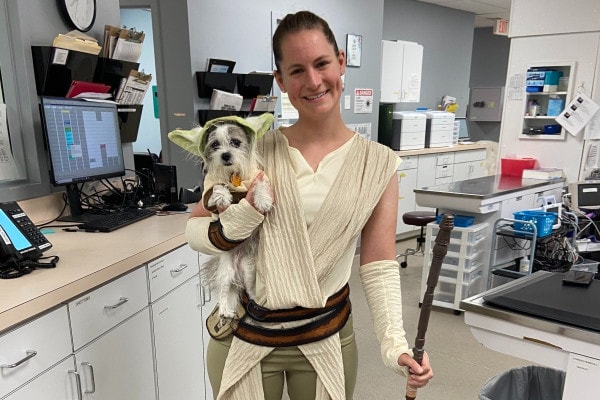
While they can be adorable, dog costumes for Halloween do pose some risks for your furry friend. Keep these considerations in mind if you decide to dress up your pet this year:
- Ensure the costume does not obstruct your dog’s vision, mobility, or ability to breathe.
- Monitor your dog while wearing the costume to ensure he or she does not chew on the costume.
- Watch your dog carefully to ensure the costume does not catch on anything and become a choking hazard.
- Consider a test run with lots of treats before Halloween to see how your dog tolerates the costume.
- Keep any photo sessions short to prevent stress.
- Be willing to skip the costume if your dog is scared or uncomfortable.
5. Decorate for Halloween with your dog’s safety in mind.
Halloween decorations are a fun way to help set the mood for the holiday. However, there are some Halloween safety tips you should keep in mind to protect your dogs and cats from harm.
Jack-o-Lantern safety
My family enjoys carving pumpkins every year, and there is no reason your family can’t enjoy them as well. You just need to take a few precautions.
Traditional candles can cause fires or burns if your dog knocks over the jack-o-lantern. Consider battery operated candles as a safer alternative, but be sure to monitor your dog around anything with a battery. The caustic chemicals in batteries can cause severe damage to the mouth, intestines, and stomach, requiring immediate emergency attention.
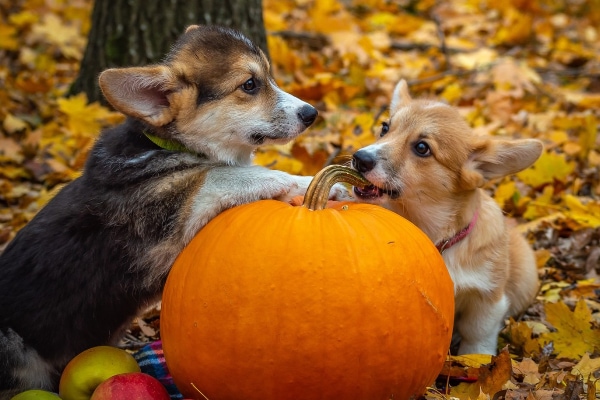
Glow stick safety
Glow sticks and glow necklaces are helpful for keeping trick-or-treaters safe while they go door to door. However, you should keep them away from your dog. The chemicals used to create the glow in glow sticks and jewelry taste terrible and can irritate the mouth, leading to pain, drooling, and in some cases, vomiting.
If your pet does get a hold of a glow stick, wipe the mouth with a wash cloth. Also, encourage him or her to drink or eat to help get the bad taste out of the mouth. Then turn off the lights to see if your pet is glowing anywhere else. If so, give your dog a bath with water and shampoo.
Also, keep in mind that glow sticks and glow necklaces contain glass to separate the chemicals until they are ready to use. If you suspect your pet might have consumed some of the glass, call your veterinarian for advice. He or she may suggest you add bread or canned pumpkin to your dog’s diet for a couple days to bulk up the feces. Additionally, you will need to watch for blood in the vomit or feces and promptly report it to the vet.
Electrical cord safety
As both a human and pet safety tip, ensure electrical cords are anchored down so they do not become a tripping hazard. Also supervise your dog carefully to ensure he or she doesn’t try to chew on the cords. Biting an electrical cord can cause burns, respiratory distress from fluid building up in the lungs, seizures, heart arrhythmias, and death.
If your dog does chew on an electrical cord, be sure to unplug the electrical cord first before touching your dog, or you could become injured as well. Then seek veterinary attention immediately.
6. Help your dog feel safe on walks and at home.
Halloween isn’t for everyone, so it’s ok if your dog doesn’t get into the spirit of the season. Some dogs are frightened by the strobe lights, ghoulish decorations, and scary costumes. If your dog is afraid of Halloween decorations, consider walking your dog before dark. That way he or she can adequately see the decorations and doesn’t get “spooked.”
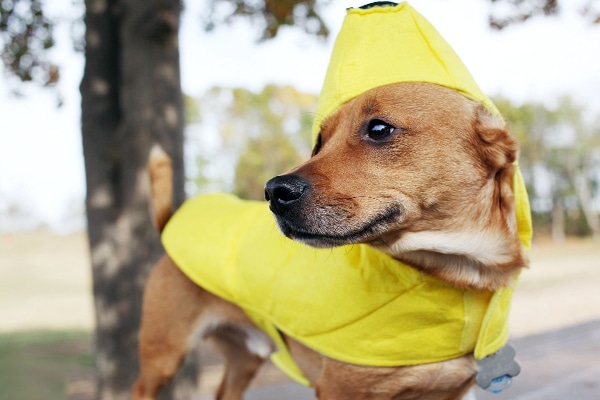
It can also be helpful to set up a quiet area in a separate room of the house where your dog can go to relax and escape the holiday hubbub. This safe haven is especially important during peak trick-or-treating time. Consider leaving a Kong toy stuffed with peanut butter or other pet safe chew toy with your dog to keep him or her entertained.
7. Check your dog’s ID
A dog who is spooked by decorations or trick-or-treaters may accidentally slip out the door and get lost. For the best chances of a quick reunion, ensure your dog has proper identification. This includes a collar with an ID tag and a microchip.
A microchip is about the size of a grain of rice and goes under your dog’s skin. It encodes a unique identification number that can be read with a microchip scanner. This is a permanent means of identification in case your dog is not wearing a collar or loses his or her identification tag.
If your dog does not have a microchip, consider having your vet insert one. It is a relatively quick procedure and does not require sedation or anesthesia.
If your dog does have a microchip, ensure the information is up to date through the microchip manufacturer. Unfortunately, I’ve seen several cases where lost dogs have a microchip but no registration information. This makes it impossible to contact the owner.
Have a safe and fun Halloween
Halloween doesn’t have to be a scary time for your dog. If you haven’t already, start to implement these Halloween dog safety tips. Also, check out the spooktacular dog safety tips infographic below. It’s a list of tricks for treating your dog to a safe and happy Halloween.
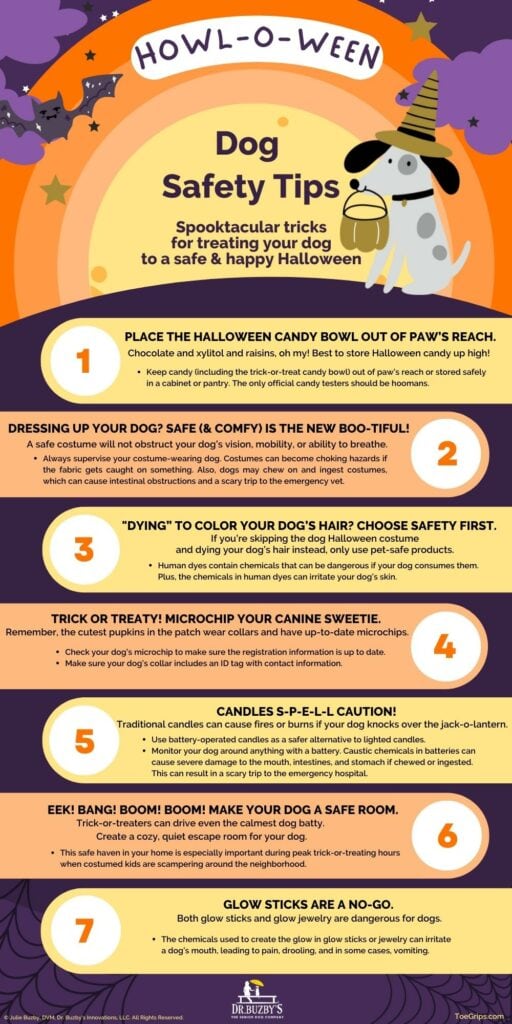
I think you will find that knowing how to keep your beloved canine companion safe during this spooky season can help you enjoy it even more.
Do you have any additional tricks for enjoying Halloween with your dog?
Please share them below.


We welcome your comments and questions about senior dog care.
However, if you need medical advice, diagnosis, or treatment, please contact your local veterinarian.